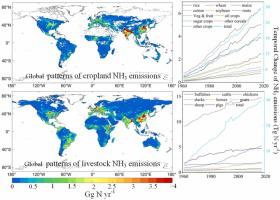Agriculture, Ecosystems & Environment ( IF 6.0 ) Pub Date : 2022-11-30 , DOI: 10.1016/j.agee.2022.108289 Yuyu Yang , Lei Liu , Pu Liu , Jia Ding , Hang Xu , Sheng Liu

|
Agriculture is the main source of ammonia (NH3) emissions which result in air pollution and degrade human health. However, the global pattern of NH3 emissions still remains uncertain, and very few studies report the crop- and animal-specific NH3 emissions both regionally and globally. Here, we developed an improved long-term (1961–2018) agricultural NH3 emissions inventory considering the detailed information of crop- and animal-specific sources at 0.5o grids. Global agricultural NH3 emissions were estimated as 39.2 Tg N yr-1 averaged over 1961–2018, driven by livestock production (58.4%) and cropland (41.6%). Cattle, rice, maize and wheat together explain about 53.4% of total agricultural NH3 emissions. Agricultural NH3 emissions increased by 225% from 18.5 Tg N in 1961–60.1 Tg N in 2018 with the increase rate of 2.1% yr-1 (for cropland 3.8% yr-1 and for livestock 1.3% yr-1). Regarding regions, China, India, Brail, Pakistan, United States and European Union accounted for over half of total agricultural NH3 emissions. The hotspots of agricultural NH3 emissions have shifted from the United States and European Union in the 1960s to China and India in recent years. Our findings benefit the understanding of agricultural NH3 dynamics by crops and animals and provide an important reference for the formulation of NH3 pollution prevention and control policy.










































 京公网安备 11010802027423号
京公网安备 11010802027423号